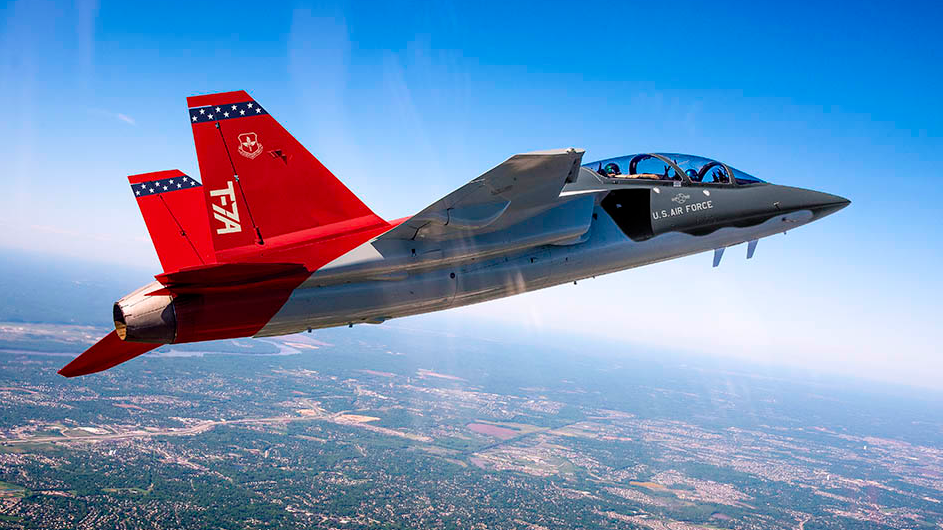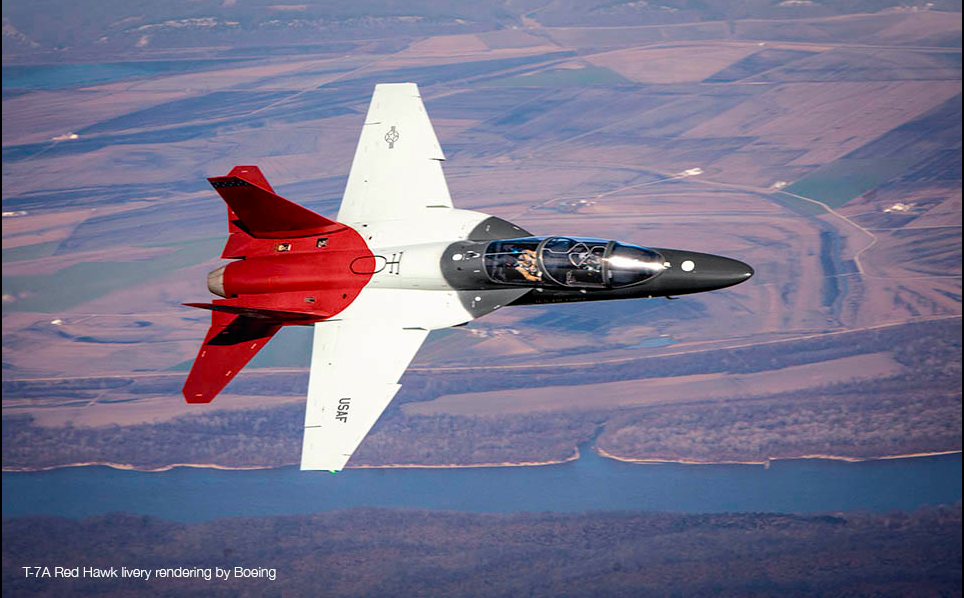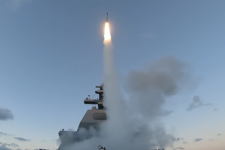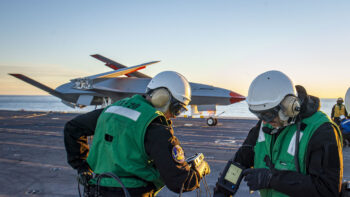
The T-7A Red Hawk, which will become the Air Force’s training jet for fighter pilots. (Boeing)
WASHINGTON — The Government Accountability Office [PDF] last week took a sledgehammer to the T-7A Red Hawk trainer’s schedule, warning that the proposed timeline carries significant risk of further delays and raising a series of other concerns — including citing Air Force officials who say the relationship is “tenuous” with Boeing over the delayed program.
“Air Force program officials said that they expect what they call a tenuous relationship with the contractor to remain a key element of managing the program, especially as the contractor continues to lose money,” the GAO wrote in the report, released May 18. “Thus, based on differing interpretations of contract requirements to date, program officials said disagreements between the Air Force and the contractor may become more likely as the contractor builds the aircraft.”
But in a series of responses to Breaking Defense, the company at points pushed back at the government watchdog’s criticism, including arguing that it is operating from outdated data.
Speaking to Breaking Defense ahead of the GAO’s report, a Boeing official shared details of the company’s reworked escape system design that will make its way into the Air Force’s own development jets used for flight testing, and expressed confidence that previous company-led test flights have smoothed the way for the aircraft’s remaining development.
“As with any development program, we encountered some challenges in that qualification testing,” Jim Young, Boeing’s program director for the T-7A’s emergency escape system, said in a May 10 interview. As a result, the program made changes to the system for a simulated ejection — known as a sled test that uses a strapped-in dummy — in February, which Young said “were validated as successful improvements.”
While noting more testing is needed to validate the design of the escape system itself, Young said the program has separately gathered about 7,000 individual data points from flights of two production-relevant jets Boeing has been flying with company pilots. The jets served as an opportunity to learn more about the trainer’s performance prior to flights with five development aircraft that will be piloted by the Air Force, which are on path for limited military flight release later this year following satisfactory results from the February sled test. (Escape system testing is reserved for sled tests to avoid risk of injury.)
“We’ve learned a lot from the T-7 program ahead of first flight of the [engineering manufacturing and development, or EMD] jets. And that goes a very long ways in getting confidence that when we get into EMD flight tests we’re not going to have major surprises,” Young said.
Yet according to GAO’s report, those flight tests carry the potential to identify new deficiencies with the jet’s flight control software, which may need as many as five-to-six additional iterations to fix. Along with at least seven more tests needed to qualify the escape system, other challenges with the trainer’s simulator and sustainment data still need to be fleshed out.
Even after development woes pushed the Red Hawk’s production decision to February 2025 and initial operational capability to January 2027, GAO seems skeptical about the current timeline, noting “the contractor’s schedule does not account for any delays during the remaining program development tasks, has an optimistic test flight schedule, and does not account for re-testing any test failures.”
The Air Force has allowed for a full year of additional delays without declaring a schedule breach, the report says, with the latest acceptable date to begin production set for February 2026.
Escape system difficulties
A top risk for greater delays stems from the test schedule for the aircraft’s emergency escape system, which GAO said will need about two years to finish. The planned seven remaining tests are scheduled to proceed every three months, a much quicker turnaround than the 15 months between a February 2023 sled test and one that preceded it, GAO observed.
RELATED: T-X: The sequel? New tactical trainer solicitation could reignite rivalries
Young explained that results from earlier sled tests “paused” further testing so that design changes could be incorporated. A key issue is accommodating a wider range of body types, a requirement from the program’s inception that Young said is mainly a concern for pilots on the lower end of the weight distribution around the “low-100 pounds,” which largely impacts female pilots but could affect male pilots as well.
“It really comes down to basic physics,” he said. “The rocket motor propels the seat out of the crew station. And the lighter weight pilot is accelerated at a much higher rate than a heavier pilot.” (The ACES 5 ejection seat used in the aircraft is manufactured by Collins Aerospace, which referred questions to Boeing.)
Boeing exclusively provided footage from the February sled test to Breaking Defense, which is included below.
Although the test showed improvements in the escape system, GAO says more work is needed to address issues with three critical steps in its activation — specifically, the aircraft’s canopy fracturing system, pilot ejection and parachute deployment.
Ejecting from the Red Hawk starts when a blast cord attached to the canopy explodes upward, blowing a hole in the glass for the pilot to escape through. According to GAO, activating the system creates what’s known as blast overpressure, or “significant pressure within the cockpit.” After previous results showed a risk of concussion in 20 percent of escapes — four times the program’s threshold of five percent — Air Force officials lowered the amount of explosives in the cord for the February test. Doing so “significantly reduced the blast overpressure in the cockpit,” though the report doesn’t say by how much.
Once the pilot is then propelled from the aircraft, “there remains a risk of canopy fragments hitting the pilot during ejection,” according to the GAO report. “In some tests,” including the one carried out in February, “large canopy fragments stuck to the test manikins as they passed through the exploded canopy,” creating the possibility of injuring the pilot or causing their seat to “rotate unsafely in the air.”
Lastly, dangers of high g-forces persist when the parachute deploys to separate the pilot from the seat, GAO found. The program made firmware updates that were included in the February sled test, and though the results showed progress, “additional improvements continue to be needed.”
And although GAO reported that “relatively minor design improvements” would “result in a fully approved and safer system,” getting the requisite testing done in time remains a chief concern due in large part to the 15 months needed between the last two tests to field design changes.
Notably, GAO appeared to identify relationship issues between the service and contractor over the tests. While GAO noted that “cooperation” between Boeing and the Air Force on the escape system “recently improved” after the service decided to fund additional sled tests, the watchdog warned that a mandate for Boeing to pick up the tab for at least four more tests “could result in a reversion back to previous levels of cooperation.” (The Air Force is funding three of the seven planned remaining tests, according to GAO, which stated Boeing is on the hook for the other four.)
“Boeing and the USAF are partnered on a path forward regarding the escape system to ensure aircrew will have the safest egress system in any trainer,” the company said in a statement. “The team completed a successful sled shot on Feb. 1, 2023 to test the system and provide confidence.”
Software, Simulator And Sustainment
Alongside the escape system, the program needs to address challenges with the T-7A’s flight control software, simulator and sustainment data. Boeing plans to deliver the final flight control software in mid-2023, but Air Force software experts interviewed by GAO said as many as five-to-six additional software iterations would be needed to fix deficiencies anticipated to crop up during flight testing. These corrections could postpone the software’s completion by more than two years and impact flight testing if more intensive changes are needed, GAO found.
“Boeing is flying with the current control law solution. This is part of our validation and verification process of flight control software,” the company told Breaking Defense. “Boeing will continue to evaluate findings and discovery during testing activities and will evaluate the need for additional software builds.”
Clarity issues with the projection system for the aircraft’s simulator also still need to be resolved, which GAO said the program’s subcontractor plans to address in 2024. Though GAO stated software that “enable[s] real-time coordination between the [T-7] aircraft and simulators” is additionally pending completion, Boeing said in a statement that “the GAO finding appears to be dated. The software in the devices is the same as in our EMD aircraft. Earlier this month we successfully demonstrated the connection and stability of our embedded training solution.”
Since the T-7A program calls for as much government-led maintenance as possible, the Air Force still needs sustainment data from Boeing to carry it out. As of January 2023, Boeing has delivered about one-third of the aircraft’s bill of materials, which GAO said is more than three years later than what the program’s contract specifies.
The Air Force needs the data not only to support an eventual fleet of 351 Red Hawks but also to sustain the service’s five development aircraft that will be used for flight tests beginning later this year, GAO reported. This issue could be resolved in time, Air Force officials told GAO, but they were dismayed by “little progress over the last year.”

T-7A Red Hawk, Boeing image
“Boeing is responsible for the maintenance of the aircraft during flight test,” the company said in a statement. “With our demonstrated performance of aircraft flights on [production-relevant] aircraft, our maintenance team is ready to support the EMD aircraft at Edwards [Air Force Base].”
Despite the availability of Boeing’s production-relevant jets, GAO found the company was only able to conduct 42 percent of 794 planned flight tests due to weather, maintenance and operations problems. Officials expect that rate of flight testing to increase once the five development aircraft that will be flown by Air Force pilots become available, but they anticipate maintenance challenges could cause delays.
Fewer test opportunities would thus cause the trainer’s schedule to slide further to the right or force the Air Force to enter production with less data. Assessing the remaining development risks, GAO found that the current schedule “includes little to no margin for failed tests, unscheduled software builds, potential escape system redesign, or other unexpected events.”
Boeing is feeling the pressure of the T-7A’s fixed-price contract that has already caused the defense giant to eat approximately $1.1 billion in charges, and Young said the company has decided to proceed at its own risk to order long-lead materials to build early production aircraft. According to Young, doing so will enable the company to be prepared for the current milestone C date or possibly beat it, though GAO noted the Defense Contract Management Agency cannot conduct oversight of the aircraft’s production through its normal mechanisms without a production contract.
RELATED: Boeing hit with fresh $245 million KC-46A charge, erasing defense sector’s Q1 profits
Costs to mend any design shortfalls on work already completed would mostly be shouldered by Boeing due to the aircraft’s fixed-price contract, though GAO noted that more delays for the program could force the Air Force to undertake additional life extensions of the T-38 Talons the Red Hawk is replacing or prolong the need to use fighters with pricey flight hours like the F-22 to conduct higher-end training.
When the Air Force originally envisioned the Advanced Pilot Trainer program in 2010, what would later become the T-7A, the service expected initial operational capability for the new fleet would be reached in 2017. Officials didn’t end up awarding a contract for the aircraft until 2018, and to date, according to GAO, the Air Force has already spent about $300 million to keep certain legacy Talons flying.
Current plans require a sum of about $750 million to conduct these service life extensions, GAO reported, warning that any further delays for the Red Hawk “could increase this cost.”
Asked what remaining development risks remained, Young said, “as with any development program, we move into flights test. And the sole reason for doing flight tests is to make sure that we have a safe system that can be provided to the fleet. And so as part of entering flight tests here shortly, we’ll begin to work through those and qualify the overall system.”
Lockheed wins competition to build next-gen interceptor
The Missile Defense Agency recently accelerated plans to pick a winning vendor, a decision previously planned for next year.


























